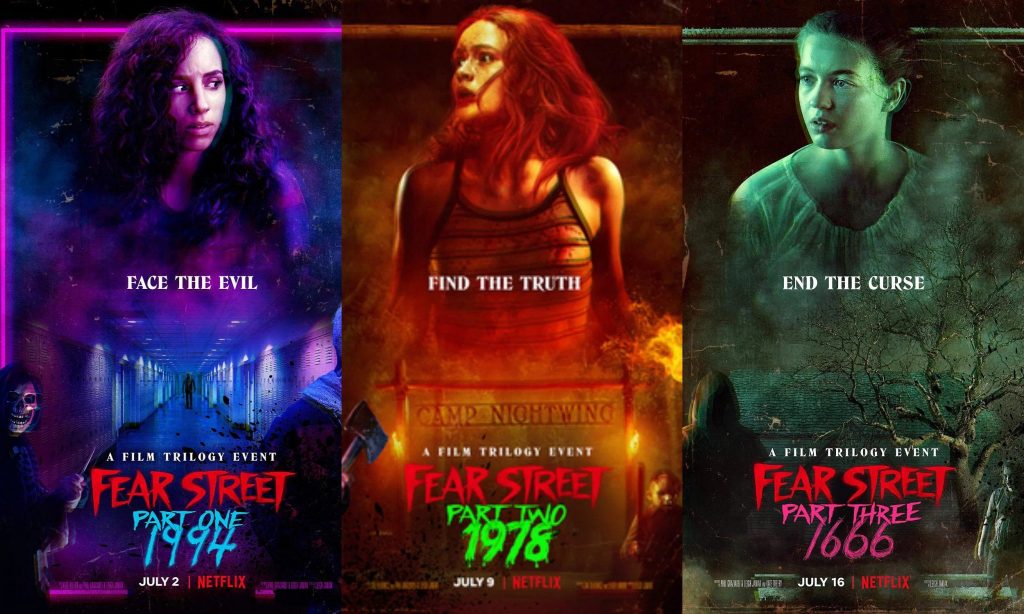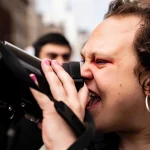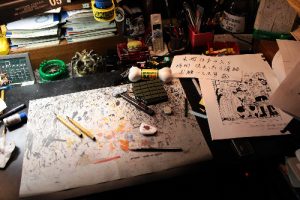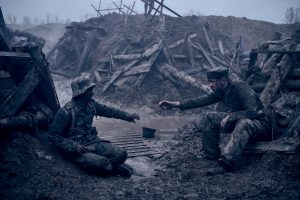Horror is a queer genre, both historically and aesthetically. However, often, these genre exercises are, at least in their own time, written off as being fundamentally unserious. As if the only way to make a queer political film is to have queer characters look at the camera and deliver the filmmaker’s specific political message. All of this is preamble to the, undoubtedly controversial, statement that Netflix’s Fear Street: 1666 is one of the most effective pieces of queer art in years.
For those who aren’t familiar with Fear Street either as a film series or a more established piece of intellectual property, it is a new series of three Netflix films based on the series of young adult books by R.L. Stine. The film series tells one overarching story of a queer, Black teenage girl in the 1990s who is trying to deal with a curse placed on her town that causes members of the town to become possessed by the devil and go on murderous rampages every few years. Each film in the trilogy is set in a different era (the 1990s, the 1970s, and 1660s, respectively) and explores how the curse manifests in each specific time. In addition to centering queer characters in each timeline, each film also functions as a delightful homage to horror films set in that era. So the 1990s entry is told in the style of 90s slasher films, the 70s is told in the style of Summer Camp horror films, and the 1600s entry is part Arthur Miller’s The Crucible and part Robert Eggers’ The Vvitch. While each entry, on its own, is a fun genre exercise with moments of representation for various oppressed communities, on their own, neither of the first two are much to write home about, from a political perspective. The final film in the trilogy, however, is able to both stand on its own as a piece of queer art and also recontextualizes the entire trilogy to be ragingly and profoundly political.
Warning: spoilers for Fear Street ahead.
Against the Determinist View of History
In the first two entries into the trilogy, Deena, our protagonist (expertly played by a sure to be awards ignored Kiana Madeira), is attempting to get to the root of the curse on her town. Through a series of plot developments, Deena and her crew learn that, in the 1600s, there was a witch (inelegantly named Sarah Fier) who, while being put to death for making a deal with the devil, placed a curse on the town. This curse, our heroes believe, is why both random violence is also inflicted on their town and also why their town is also severely economically depressed as compared to the neighbouring town, which is rich and prosperous. However, as Deena and her revolving cast of supporting characters begin to uncover, there seems to be more to the story that meets the eye. It also begins to become clear the family that has held political and legal power in the town for generations — the equally inelegantly named “Goode Family” — seems to know more than they are letting on. Eventually the second entry — which, while it lacks the political het of the third film, is a lot of camp-y fun — ends with Deena finally reuniting the witch’s hand and her body. But, rather than ending the curse, Deena is immediately yanked back into the witch’s story and the third film opens promising to show us what actually went on in the 1600s. It is here that Fear Street transcends it’s young adult conventions and begins to really cook with gas.
What Fear Street taps into is that American culture and history is built upon the legacy of oppression. This legacy not just created but actively supports the current balance of power in favor of the capitalists both materially and ideologically. This ideological hegemony is maintained by the systemic whitewashing of history. From the burning of Black Wall Street in Tulsa to the violence in Wilmington, North Carolina to the full-scale destruction of Rosewood, Texas, countless horrific acts of violence unleashed in order to defend capitalism have been wiped from our history. The burning of women at Salem — a clear act of misogyny fueled by extremist religious pressure — has been historicized as a fun ghost story and now Salem is a major tourist destination. This whitewashing of history allows the system to exonerate itself by omission.
Fear Street leans into rather than ignores this, which makes for a compelling and intense look at the ways in which capitalism functions. What Deena’s witnessing of Fier’s story shows both her and us is that, in fact, the story is very, very different from the one that has become accepted history. Rather than, in actuality, being a witch in bed with Satan, Fier (played in these flashbacks by Madeira with white-hot rage) is actually a young queer woman first beginning to experiment with her sexuality. This runs afoul of the conservative Christian values of the time and Fier and her partner are immediately blamed for all of the town’s problems.
While attempting to escape the literal lynch mob after her and rescue her partner, Fier stumbles upon the actual plot of the trilogy: a local farmer, a member of the Goode family, has, in fact, made a deal with the devil where he will literally trade the lives of other people in the town for power and prosperity. From this one (white) man’s actions, develops the rest of the “curse” of the town: rather than it being one curse that was laid hundreds of years ago, the curse is being actively perpetuated by members of the Goode family when they literally trade the lives of the less privileged for wealth and power every few years. The metaphor isn’t hard to miss.
There is also a class element to this: the “cursed” area (Shadyside) is known as the “bad side of town” while the other side (Sunnyside) is a prosperous haven of the upwardly mobile middle class. That the “good side” of town is only able to have their prosperity because of the literal blood of Shadyside is the perfect metaphor for capitalism. The ruling class is able to live lives of luxury because of our blood, sweat, and tears.
Against Trauma Porn
As part of the offensive of rainbow capitalism in recent years, representational politics have become relatively common in mainstream films. Many big-budget films have at least a nod to queer audiences, typically as a way of generative positive headlines for their capitalist overlords. While this is a progressive shift, it has resulted in a series of “blink or you’ll miss it” visions of representation. In none of these cases are anything about the films themselves queer. Rather, they are exclusively heteronormative stories that offers little for actual queer people.
One thing that separates Fear Street from the glut of “representational politics” based content is that it makes the characters’ queerness foundational to both their characters and the overall themes of the work. In other words, it isn’t just a work with queer characters but a work about queerness. Both Deena and Fier are defined, in different ways, by their queer experiences. This doesn’t mean, however, that they are defined by their trauma.
Too often, in the nominally “queer” films we are asked to passively consume, the experience of being queer is made tantamount with the trauma of being queer. Countless examples of queer art, almost exclusively not made by members of the queer community, elevate the traumatic elements of queerness — repression, discrimination, violence, etc — to being synonymous with the queer experience itself. On the other hand, there is also now a preponderance of “post-oppression” art which asks us to believe that we are currently living in a world where queer people can go about their lives without any risks. Both of these visions are inaccurate and total failures at representing what queerness actually.
Fear Street is refreshing in showing that, in the words of Utah Philips, the people who oppress us have names and addresses. Capitalist oppression isn’t a witch’s curse that we have to suffer nobly but, rather, something that is being actively perpetuated by those with power. We can take great steps towards ending this oppression and aiding the liberation of desire by overthrowing the capitalists. In this sense it does feel somewhat revolutionary for Fear Street to end with a Black, queer woman stabbing a police officer in the eye and then kissing her partner atop his grave. Fear Street is textually telling us that, in order to live our freest and most liberated lives, we must get rid of the people who are oppressing us. This doesn’t mean, of course, that every oppressed person should go kill the individual people who are oppressing them but, rather, that the system that oppresses us must be fought, brough to its knees, and summarily executed.
Against Despair
Perhaps the most striking and effective thing about Fear Street is how it refuses, in all three installments, to fall into pessimism or despair. We are currently living in a time where material conditions across the globe are steadily worsening. Between climate change, imperialist aggression, economic depression, and state- and right-wing violence, it can be easy to fall into despair about the current situation. But we should be clear that despair stops us from fighting for more, because we assume that it will be hopeless. Despair is what leads us into compromised strategies, hoping to make things a little better now. Despair leads us out of class struggle, out of organizing, out of public. Despair can be a natural reaction to material conditions but it is never a productive reaction.
Art can fight despair. Art allows us to recognize our collective experiences, find community, and name the injustices that we face. In the words of Andrea Abi-Karam & Kay Gabriel: “Poetry isn’t revolutionary practice; poetry provides a way to inhabit revolutionary practice, to ground ourselves and each other, to think about an unevenly miserable world and to spit in its face.”
In this sense, Fear Street is a great example of how art can let us spit in the face of a miserable world. It shows us very recognizable instances of oppression and then paints a portrait of how we can resist those. The text of Fear Street argues that oppressed people must overthrow their oppressors, with violence if necessary, and then live, love, and continue on-top of their graves. That is an artistic abstraction of the need for revolution. Obviously, we do not think the answer to oppression is for each oppressed person to kill their individualized oppressors, but within the metaphor that Fear Street presents, the conclusion of that metaphor is that a violent revolution is needed — our heroes literally begin their assault upon the powerful by shouting “For Shadyside”. It shows that only collective struggle against the state (the villain is the sheriff of the town and his brother is the mayor) and the capitalists can bring about our collective liberation.
I have previously written, for Left Voice and others about the need for the development of a new political art. Fear Street, surprisingly, offers a good vision of how to square the circle of making art that is both entertaining to mainstream audiences and putting forward a coherent anti-capitalist message. It also is exceedingly unusual in being a piece of political art that doesn’t pull punches but also ends in an inspiring place.
As an example of the power of the film, there is a scene near the end of the trilogy where Fier’s friends dig up her body after she is lynched and move her to give her a proper burial. In place of the body, they leave a rock with “the witch forever lives” carved on it. This meaningfully recontextualizes the earlier films and shows us a powerful image of the power of the continuity of struggle.
As revolutionaries, sometimes, we can fall into the idea that if we aren’t the generation that is successful at overthrowing capitalism that we have failed and accomplished nothing. This “all or nothing” approach is very understandable but ahistorical and anti-dialectical. We, all of us, are in the struggle today because of people who have come before. In Fear Street, Deena is only able to defeat the Goodes by building off of the work that was done in earlier decades. Fear Street tells us that fighting against capitalism and racism is vital, even if it isn’t successful in the moment.
For those of us in the struggle against capitalism, we should take a page out of Fear Street’s book and look to our history. The revolutionaries who came before us have laid the path for us and created a revolutionary continuity that we can tap into for lessons, guidance, and encouragement. In this sense, documenting, analyzing, and studying history is not just important theoretically but a deeply necessary thing to do to resist despair. We are not alone, isolated radicals screaming into the maw of neoliberalism. We are building off the work and theory of fighters who have come before us. Even if it is not our generation that succeeds, we are laying important groundwork for future revolutionaries. As long as there are workers and exploiters, as long as there is gender oppression, as long as there is queer oppression, as long as there is imperialist violence, as long as capitalism stands there will be revolutionaries. The witch forever lives and the struggle goes on.











